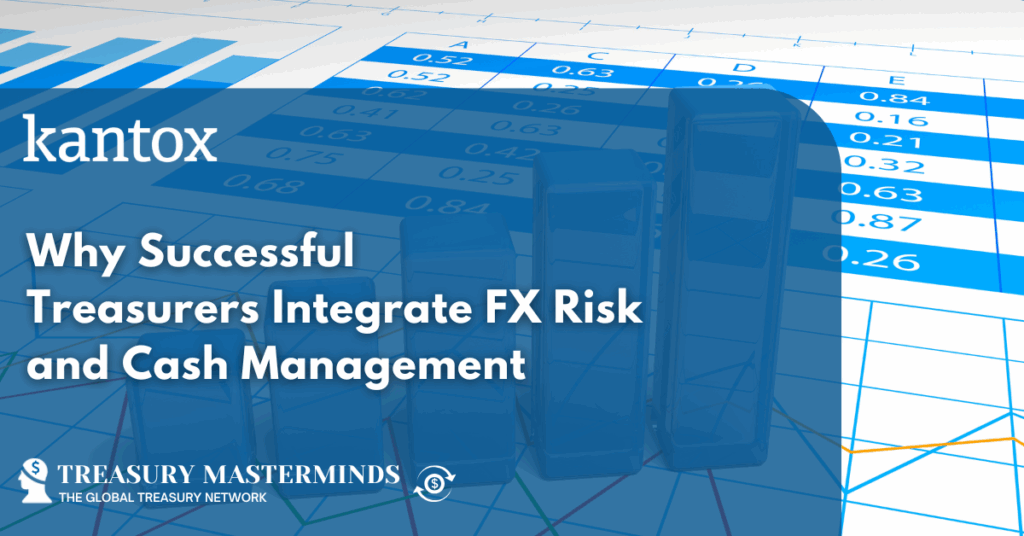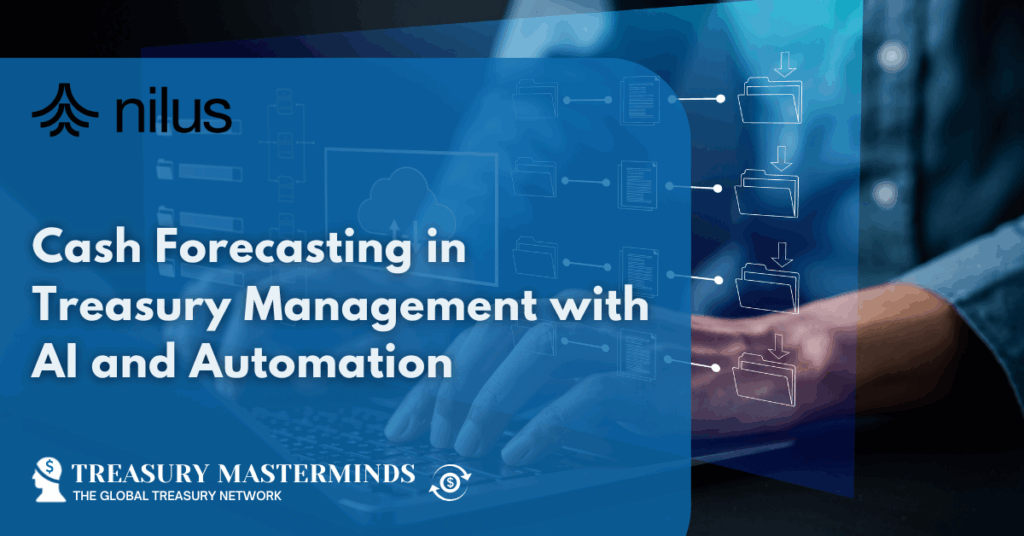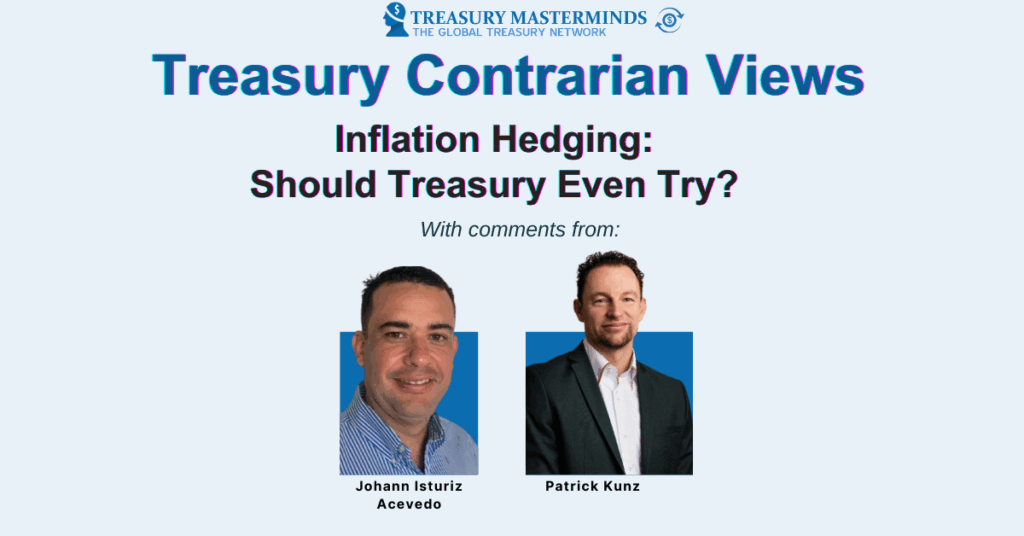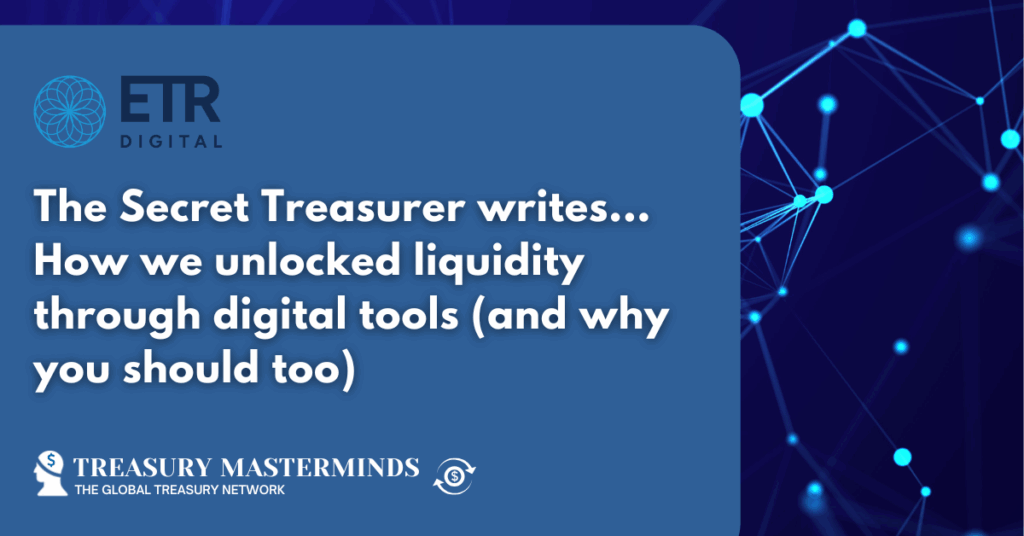
Why Successful Treasurers Integrate FX Risk and Cash Management
This article is written by Kantox As treasurers watch global equity, credit, and FX markets wobble on each utterance from U.S. President Donald Trump, they quietly prioritise cash and liquidity management tasks. Meanwhile, recurrent episodes of financial volatility are putting the spotlight on the multifaceted interactions between FX and capital markets. Whether FX liquidity falls on “tariff volatility”, CHF reaches record highs across the board, or DKK weakens against EUR, you get the point: currency markets considerations are top of mind as treasurers beef up their cash and liquidity management capabilities. We can only expect more such episodes going forward. Micro-hedging and cash flow forecasts Amidst the flurry of reactions to Mr Trump’s tariff measures, Shopify, the U.S.-based e-commerce platform, is decidedly embarking on a policy to sell in more currencies. Although we are not privy to any information on the matter, the firm’s Form 10-K says it loud and clear: “We have launched localised pricing plans in select countries where we bill in local currency in order to reduce friction and attract more merchants to our platform. As our operations continue to expand internationally, we may observe additional risk in other foreign currencies” — Shopify As the treasury team updates its 30, 60 and 90-day cash flow forecasts, the FX element coming from foreign sales will introduce an added element of instability. While textbooks suggest hedging the transaction cash flow exposure, things are more complicated in real life. To begin with, the relevant data may be located in different company systems: ERP, TMS, and spreadsheets. On top of that, a rule for aggregating exposures is needed. And what about forward points management? CHF trades at a forward premium to USD, but BRL does so at a deep discount. This requires different approaches. There is a way out of these practical dilemmas. Micro-hedging programs provide finance teams with the flexibility to remove any FX-related uncertainty in their cash flow forecasts. This is because they rely on API connectivity to capture the exposure from any company system, delaying hedge execution when needed. The ‘cash flow moment’ of FX risk management In the magic world of textbooks, there is no time lapse between the settlement of a commercial transaction and the corresponding FX derivatives instrument. But real-world treasurers know it too well: most of the time, a lot of swapping is required. Time and again, we encounter situations where members of treasury teams manually execute the time-consuming transactions needed to perform early draws on existing forwards, or to rollover existing forward positions (much more on this specific topic in our next blog). The good news is that relief is at hand. Swap execution that comes with Currency Management Automation frees up resources and removes operational risks and costs. Whether they anticipate or roll over FX derivatives transactions linked to payments / collections, treasurers can execute the process in just one click. With complete visibility and control, the finance team obtains: A liquidity management upshot As they embark on the journey to sell in the currency of their clients and buy in the currency of their suppliers, firms like Shopify are in for a pleasant surprise. The decision is likely to yield benefits that go beyond the aims of “reducing friction and attracting more merchants to our platform.” The strategic orientation to use more currencies in commercial operations also produces a number of liquidity management and working capital-related benefits. In this age of Trade Policy Uncertainty, these advantages seem compelling enough: Ensuring liquidity at all times Now consider the case of the global pharmaceuticals, biotech, healthcare, and cosmetics company Gerreshimer. (Again, we are not privy to any information on their FX policies). In the 2024 Annual report, we read that the German group’s finances are: “… controlled and optimised centrally […] Our primary goal is to ensure liquidity at all times by procuring funding on a centralised basis and actively managing foreign exchange risks and interest rate risks” — Gerresheimer This is a model for a well-organised treasury governance setup. Here, again, we can report good news from the treasury technology front. Scalable tools that were once exclusive to large enterprises make it possible for any firm with foreign subsidiaries to implement solutions like Kantox In-House FX. The main benefits include: Conclusion: numerous and meaningful touch-points By introducing a neat distinction between tasks, most treasury surveys enumerate sets of priorities that are seemingly separated from each other. Courtesy of various crises, cash and liquidity management issues have consistently claimed a top position in most rankings. But are these treasury surveys taking the right approach? This blog showed that a clear separation of treasury tasks does not correspond to the real world. The touch-points between FX risk management and cash and liquidity management are too numerous and too meaningful to ignore. It is only when we abandon the siloed approach between tasks that we realise how much technology is bridging the gap between FX risk management and cash and liquidity management, to the point of making them virtually inseparable. Also Read Join our Treasury Community Treasury Masterminds is a community of professionals working in Treasury Management or those interested in learning more about various topics related to Treasury Management, including Cash Management, Foreign Exchange Management, and Payments. To register and connect with Treasury professionals, click [HERE] or fill out the form below to get more information. Notice: JavaScript is required for this content.

Open Banking: A Missed Opportunity for Corporate Treasurers in the UK and EU?
By Treasury Masterminds Open banking, heralded as a transformative force in financial services, has yet to deliver its full potential, particularly for corporate treasurers in the UK and EU. While the concept promises enhanced data sharing, streamlined financial processes, and improved efficiency, the reality has been marred by slow adoption, regulatory challenges, and technical complexities. Slow Adoption: A Global Perspective In the UK, open banking’s journey began with regulatory mandates aimed at fostering competition and innovation. However, consumer adoption has been tepid. For instance, in March 2025, open banking payments totaled just 27 million, a stark contrast to the 1.92 billion card transactions in February. This disparity underscores the challenges in shifting established payment behaviors. Similarly, across the EU, the implementation of open banking has been inconsistent. Countries like France and Spain have made strides, but others lag due to varying regulatory approaches and market readiness. As adoption remains slow in both regions, businesses—including corporate treasurers—find it difficult to justify the investment in open banking systems without a proven, widespread user base. Challenges Hindering Adoption Several factors contribute to the sluggish uptake of open banking: 1. Lack of Consumer Incentive While open banking offers numerous advantages—such as enhanced control over payments, greater transparency, and better access to financial products—the incentives for consumers to adopt it have not been compelling enough. Corporate treasurers, too, face challenges as businesses are often risk-averse when adopting new technologies without clear, measurable benefits. Despite regulatory efforts, adoption remains slow. Without a strong consumer push to adopt open banking services, businesses find themselves unable to leverage the full potential of the systems. 2. Security and Privacy Concerns Security remains one of the most significant barriers to the adoption of open banking. For consumers and businesses alike, trusting banks and fintechs with sensitive financial data is no small matter. The idea of open APIs that allow third-party providers access to banking information raises serious concerns over data privacy, identity theft, and fraud. 3. Fragmented Standards Open banking, as it currently stands, is far from a one-size-fits-all solution. In both the UK and EU, there is no uniform technical standard across financial institutions. Different banks have adopted different API frameworks, authentication mechanisms, and data-sharing protocols. This fragmentation means that businesses and treasury teams have to deal with varying levels of integration complexity when trying to connect with multiple financial service providers. 4. Regulatory Complexity Open banking is heavily regulated, with different requirements and standards across countries. The EU’s Revised Payment Services Directive (PSD2) governs the open banking landscape, but its interpretation and enforcement differ from one country to another. Similarly, the UK has its own regulatory framework post-Brexit, which complicates cross-border adoption. 5. Lack of Readiness Among Banks and Fintechs While the regulatory environment may be pushing for open banking, many banks and fintechs have been slow to fully embrace and implement the necessary systems. Many banks still operate with legacy technology, which makes it difficult to integrate open banking APIs into their infrastructure. Additionally, fintechs, while innovative, often lack the resources or expertise to develop secure, reliable APIs that comply with all relevant regulations. 6. Adoption Costs Implementing open banking can require a significant upfront investment. While it promises cost savings and efficiencies in the long run, many businesses—especially SMEs—are deterred by the initial costs of setting up the necessary infrastructure. For corporate treasurers, investing in the technology to integrate open banking systems into their TMS (Treasury Management Systems) may seem like a luxury if they are not convinced of the short-term returns. Looking Ahead Despite these challenges, there is cautious optimism. The EU’s proposed Financial Data Access (FIDA) regulation and the UK’s Data Use and Access Bill aim to standardize data sharing practices, potentially paving the way for more cohesive open banking ecosystems. For corporate treasurers, staying informed about these developments and actively engaging with industry initiatives will be crucial in leveraging the benefits of open banking as they materialize. Conclusion Open banking holds significant promise for corporate treasurers in the UK and EU. However, realizing this potential requires overcoming existing barriers related to adoption, integration, and regulation. With concerted efforts from regulators, financial institutions, and businesses, open banking can evolve from a concept to a cornerstone of modern corporate finance. Also Read Join our Treasury Community Treasury Mastermind is a community of professionals working in treasury management or those interested in learning more about various topics related to treasury management, including cash management, foreign exchange management, and payments. To register and connect with Treasury professionals, click [HERE] or fill out the form below to get more information. Notice: JavaScript is required for this content.

Cash Forecasting in Treasury Management with AI and Automation
This article is written by our content partner, Nilus Cash forecasting used to be a “nice to have.” Now it’s survival mode. Whether you’re a public company, a multinational corporation, or a fast-growing startup, your treasury team can’t afford to fly blind. Visibility into future cash flows isn’t just helpful, it’s how you plan for growth, manage risk, and avoid nasty surprises when markets shift (which they always do). The problem? Traditional forecasting is slow, manual, and often… wrong. That’s where AI and automation are increasing accuracy while reducing manual workloads. In this guide, we’ll break down the building blocks of effective treasury cash flow forecasting, explore practical ways to optimize your process, and show you how AI can turn forecasting from a reactive task into a strategic advantage. The Critical Role of Cash Forecasting in Treasury Management Cash forecasting in treasury management is more than just an operational task – it’s a strategic necessity. Here’s why: Liquidity Management: Companies must ensure they have enough cash to meet obligations without holding excess reserves that could be better invested elsewhere. A company that sits on excess cash is leaving money on the table. Finance teams have the opportunity to be a revenue generator by taking advantage of excess cash and investment opportunities. Risk Mitigation: Cash management is a balancing act. Yes, maximizing investment returns is a critical function, but by overinvesting and not maintaining enough liquidity, companies leave themselves vulnerable to unanticipated changes in the market. Unexpected cash shortfalls can result in missed payments or costly emergency borrowing. Accurate forecasting can prevent these financial shocks. Strategic Planning: Businesses rely on forecasts to make investment, financing, and operational decisions. For example, retail businesses with high seasonality need accurate forecasts to help prepare for low revenue periods and maintain the right level of inventory for high revenue periods. Without a forecast, these businesses are flying blind and risk costly mistakes (like the cash shortfalls mentioned above). Compliance & Regulatory Requirements: Many industries require detailed cash forecasting reports to meet regulatory standards. For example, banks must complete detailed forecasts in order to maintain mandated liquidity levels. For regulated industries with liquidity requirements, forecasting is even more vital. Without a robust treasury cash flow forecasting process, organizations risk inefficiencies, increased borrowing costs, and potential financial distress. Whereas a strong cash forecasting process can help companies increase revenue from investments, weather market variations stronger than competitors, and bring the financial stress level down for the entire organization. That last one shouldn’t be overlooked. Key Components of Accurate Cash Forecasting You’ve probably heard it before: cash forecasting in treasury management is part science, part art. But no matter how you slice it, there are some core steps that make or break your forecast. Here’s what needs to be in place for a forecasting process that’s both reliable and repeatable: 1. Start with Clean Historical Data Before you can predict the future, you need a solid handle on the past. Pull actual historical cash flow data – at minimum, a year’s worth – and make sure it’s categorized correctly. This gives you a baseline to identify trends, seasonality, and outliers. 2. Pull Future-Dated Transactions from Your ERP The best forecasts combine historicals with what’s coming down the pipeline. That means syncing your ERP or accounting system to include scheduled inflows and outflows: think customer invoices, vendor bills, payroll runs, loan payments. This turns your forecast from backward-looking to forward-facing. 3. Set Categories That Match How You Manage Cash Your categories should reflect how your business thinks about cash. Operating, investing, financing, but also more specific buckets like “enterprise customer payments” or “cloud infrastructure costs.” Clear categories help both in building the forecast and explaining variances later. 4. Define the Forecasting Period Cash forecasting methods vary depending on how far out you’re looking. Regardless of your time horizon, make sure your period aligns with your decision-making cycles. 5. Choose the Right Cash Forecasting Method There’s no one-size-fits-all approach. Most treasury teams use a mix: The key is picking the method that aligns with your needs, and being consistent in applying it. 6. Run Variance Analyses – And Learn From Them Forecasting isn’t a set-it-and-forget-it exercise. Once actuals come in, compare them to your forecast. Where were you off? Were there surprises in receivables timing or unexpected expenses? Regular variance analysis helps refine your process and improves accuracy over time. 7. Adjust and Iterate Forecasting is a living process. As new data becomes available – updated invoice schedules, shifting customer payment behavior, changes in burn rate – fold it into your model. AI and automation can help, but even basic manual adjustments go a long way. How to Optimize Cash Forecasting in Treasury Management Accurate cash flow forecasting is critical for maintaining financial stability, optimizing working capital, and making informed strategic decisions. To improve forecast accuracy and avoid unnecessary financial risks, follow these four best practices: 1. Automate Data Collection Manually gathering cash flow data from multiple accounts and systems is time-consuming and error-prone. Treasury teams should leverage automation tools to pull real-time cash flow data from multiple sources like banks, ERPs, and payment platforms to improve accuracy. 2. Categorize Inflows and Outflows Strategically Break down your cash flow drivers to gain deeper insights and improve forecast precision. Closely track key inflows (customer collections, financing, asset sales) and outflows (supplier payments, payroll, capital expenditures). You can adjust your granularity based on business needs – detailed segmentation isn’t always necessary. 3. Enhance Collaboration Across Departments Finance and treasury teams should work closely with departments that influence cash flow, such as sales, procurement, and FP&A, to ensure all relevant data points are included in forecasts. Sync forecasts with financial reporting cycles to ensure they incorporate the latest actuals. And communicate findings effectively – tailor insights for different audiences, from CFOs to department heads. 4. Leverage AI and Predictive Analytics AI-powered forecasting tools enhance accuracy by analyzing historical patterns and external market trends in real time. By integrating your past performance, current…

When playing it safe is the biggest risk: GoCardless’ CFO tells all
This article is a contribution from one of our content partners, Bound Most CFOs learn about cash management gradually. But Catherine Birkett had the dubious privilege of being thrown in at the deep end in her first CFO role – managing a €10m monthly burn rate with barely any revenue. Here, she explains why a crisis isn’t to be feared but embraced as a chance for bold, calculated moves – and highlights how her journey from telecoms to fintech has taught her that sometimes the biggest threat is avoiding risk altogether. A crash course in cash burn Now steering the finance function at GoCardless, Catherine’s CFO journey began in the high-stakes world of telecom with Interoute, a company she candidly describes as “nearly bankrupt” when she joined. “We were burning €10 million monthly post-dot-com crash,” she recalls. “Every Monday, I asked myself the same question: ‘Can we make payroll this week?’” It was undeniably a tough gig, especially for someone stepping into the CFO role for the first time. But known for her pragmatic approach (she is a proud northerner, after all!), Catherine tackled the challenge by creating a “three-horizon framework” that balanced short-term survival with long-term growth. “I asked myself three questions: what has to happen today to keep us afloat? What needs to happen this month to stabilise? And what should happen this quarter to build for the future?” That framework, born out of necessity, has become a guiding principle throughout her career, helping to keep immediate financial needs in check without sacrificing long-term strategy. “When you’re staring down the barrel, you can’t afford to overthink,” she advises. “Sometimes, survival means moving faster, trusting your gut, and accepting that waiting for perfect information is a luxury you don’t have. You just have to get on with it. But having that daily, monthly, and quarterly plan can at least provide an anchor in a sea of chaos.” To help prevent these kinds of situations in the first place, Catherine advocates focusing on building resilience. “Cash is king, especially when the world is so unpredictable. I’m always thinking about cash reserves,” she says. “Having a cash buffer isn’t just about security, it’s about freedom. As CFOs, it lets us make strategic decisions without the desperation that can come from being cash-strapped.” Risk can be your best friend (sometimes) Despite her love for financial security, Catherine doesn’t buy into the conventional wisdom that playing it safe is always best, certainly when it comes to strategic decision-making. For example, there were often times at GoCardless when the need to invest to grow the business had to be considered alongside cost control. This was particularly evident during Covid when, together with her CEO, she persuaded the board not to make such severe cutbacks despite the uncertain macro-economic environment – to ensure the business could continue to grow. A move which proved successful as, after an initial drop in revenues, the business continued to flourish. For Catherine, risk management isn’t always about dodging uncertainty – although of course there is a large amount of that too – but also about knowing when to bet on it. “I think there’s a myth in finance that caution equals safety. But in a high-growth market, standing still can be the riskiest move of all.” FX strategy: certainty over speculation Although she advocates for taking calculated risks in some areas, FX is not one of them. Her approach at GoCardless is to focus on stability over speculation. “You’re not a forex trader. You’re a CFO. Certainty is what matters,” she says. “If you’ve budgeted at a rate, lock it in and move on. Don’t gamble.” One formative experience stands out for her. In 2016, just months before Brexit, Interoute acquired a sterling-based business, only to see the currency plummet. “Overnight, the revenue value in sterling dropped. Thankfully, we were hedged, so the bottom line wasn’t impacted, but explaining that shift to stakeholders was a nightmare,” she recalls. “You can’t predict everything, but you can prepare for the worst. Locking in certainty always outweighs speculative gains.” Not hiring clones Elsewhere, Catherine likes to take a deliberate approach when it comes to building her finance team, with her key consideration being that their strengths fill her weaknesses, and not opting for people just like herself. “Early in my career, I thought I’d made the perfect hire – someone who mirrored my approach exactly. But it turned out to be a complete disaster,” she laughs. “Two people with identical strengths mean identical blind spots.” Since then, she’s flipped her hiring strategy entirely. Today, her team at GoCardless is intentionally diverse in both thought and approach. “My current financial controller and I have completely different styles. They catch what I miss, and I catch what they might overlook. It’s a balance,” she says. By hiring people who think differently, Catherine ensures her team brings fresh perspectives, fewer blind spots, and a stronger ability to handle complex challenges. “You don’t want clones – you want different opinions, and people who are prepared to question. That curiosity creates checks and balances.” The human element of the CFO role is becoming more and more critical, believes Catherine. Aside from good hiring strategies, soft skills are increasingly in demand – especially the art of communication with the board. To Catherine, board meetings aren’t for show, they’re for setting direction. Recently, she faced a boardroom showdown where competing priorities were stirring up tension. Instead of pushing a single recommendation, she presented a “decision map” that laid out multiple pathways. “Rather than focusing solely on numbers, we mapped out three paths: conservative, balanced, and aggressive growth. But we didn’t just show figures. We demonstrated how each choice would affect everything: product roadmap, talent acquisition, market positioning, and customer experience,” she says. This approach shifted the discussion to the bigger picture, enabling the board to focus on what mattered most to the business. “It’s not about knowing every answer,” she explains. “It’s about being able to shift the…

Treasury Contrarian View: Inflation Hedging — Should Treasury Even Try?
Inflation is back in the headlines—and so is the pressure on treasury teams to protect company value. But here’s the provocative question: Should corporate treasury even try to hedge inflation? Or is it a costly distraction that’s outside treasury’s control and best left to pricing, procurement, and operations? The Case for Treasury Getting Involved in Inflation Hedging The Case Against Treasury Owning Inflation Hedging A Coordinated Approach Rather than owning inflation hedging outright, treasury teams can: Let’s Discuss We’ll feature perspectives from treasurers and risk experts—join the conversation and share your thoughts! COMMENTS Johann Isturiz Acev, Treasury Masterminds Board Member, comments: A shared model between Treasury and other internal areas look like most convenient. We see treasury sharing historical data and market products and procurement/commercial team finding a common sense to protect margin and avoid P&L swings. So, a case by case and country/market analysis have to be done in each transaction to measure the risk and impacts. Patrick Kunz, Treasury Masterminds Founder and Board Member, comments: The article makes inflation sound like a bad thing. Which it CAN be, rising costs or indirect adverse effects on exchange rates or interest rates. But it can also be good. IF you can increase your prices with inflation the companies revenue will increase, even if costs also increase as revenue should be the higher compared to cost so inflation makes this go up faster. When debt stays the same your relative debt position will decrease, without much effort. So much for a perfect world where you can 1on1 increase your prices with inflation, without unhappy clients. Can treasurers directly hedge inflation ? It is possible with slightly more complex derivatives. Will they be effective ? never 100% as the treasurer will never fully know its exact exposure on inflation. So do nothing? No, we can (and should) hedge the inflation proxies: interest rates and FX. We can much better determine the exposure on IR and FX. We therefore can decide on a risk appetite and how much to hedge (or not to hedge). I also like the inflation protection clauses, both on the procurement and the sales side. These can protect your COGS or your sales by limiting the inflation impact. Limiting, never fully mitigating. As with hedging where one party wins the other loses in these clauses. Fairness rules. But for these clauses treasury would not be in the lead but can act as advisor to the procurement and sales teams, if they are willing to listen. By all means challenge me on this views, would love a discussion on this topic. Also Read Join our Treasury Community Treasury Mastermind is a community of professionals working in treasury management or those interested in learning more about various topics related to treasury management, including cash management, foreign exchange management, and payments. To register and connect with Treasury professionals, click [HERE] or fill out the form below to get more information. Notice: JavaScript is required for this content.

The Secret Treasurer writes… How we unlocked liquidity through digital tools (and why you should too)
This article is written by ETR Digital Like every corporate treasurer, one of my main jobs is to make sure there’s enough liquidity to keep the business running smoothly, support growth, and give us the financial flexibility we need. But that’s often easier said than done! Lately, I’ve been exploring some different tools for unlocking working capital. And with everything going on in the digital trade space, I figured I’d take a look at Digital Negotiable Instruments (DNIs). Because they can help speed up payments and receivables processes, unlocking significant amounts of liquidity and improving cash flow management. Wait, what are DNIs? Good question! And I only discovered them through a session at an industry conference, so you’re not alone in never having come across them. In a nutshell, DNIs are essentially the digital version of old-school paper trade instruments like bills of exchange and promissory notes. But instead of dealing with stacks of paperwork and slow manual processes, everything’s securely handled on a digital platform. So, it’s nothing totally new and risky, it’s an innovative way to approach an age-old challenge. In practice, DNIs mean faster, clearer transactions – and much less waiting around. Where paper-based instruments might take days or even weeks to settle, DNIs can be wrapped up in a fraction of the time. That’s a big win when you’re trying to unlock liquidity. How DNIs helped us release trapped cash Before using DNIs, we were facing a pretty common issue: too much working capital was tied up in slow trade cycles. We had payables and receivables stuck in the system, delaying access to cash we could’ve been using elsewhere in the business. I’m sure that feels like a familiar frustration. Then we decided to start using DNIs (it wasn’t a tough switch). And the difference was like night and day. Take our cross-border transactions. They used to be really paper-intensive, taking weeks to finalise payments and get funds moving. But with DNIs, we’ve cut down the processing time dramatically. That’s helped us speed up cash inflows and bring down our DSO. We also brought DNIs into our supplier financing programme. Again, easy to do. And it meant that suppliers got paid faster, we improved our own cash conversion cycle, and we could even extend our own payment terms without damaging supplier relationships. A win-win (yes, it might sound a bit clichéd but it’s true). Finding the hidden liquidity Those few switches have made all the difference already. And it was easy to know which working capital ‘levers’ to pull because I used the ICC’s free Cash Conversion Cycle Calculator – and it showed me exactly where our cash was getting stuck. So, I encourage you to check it out https://ic4dti.org/getting-started-ccc/ It’s super easy to use, anything you plug in is private, and it will give you a clear picture of where your working capital could be improved. For us, unsurprisingly, a lot of the inefficiencies were from outdated trade processes. But digitalising them has made a huge difference almost immediately. Seeing is believing If, like me, you’re a corporate treasurer looking to make your cash work harder, I can’t recommend DNIs enough. They’ve helped us streamline operations, reduce delays, and unlock liquidity that was previously gathering dust in slow-moving processes. They’re essentially just a better version of what was there before. Like upgrading from a landline phone (or carrier pigeon in some instances!) to the latest smartphone. And if you’re not sure where to start, give the ICC’s Cash Conversion Cycle Calculator a try. It’s a quick way to spot opportunities to improve your cash flow – and helps put you in control. Also Read Join our Treasury Community Treasury Masterminds is a community of professionals working in treasury management or those interested in learning more about various topics related to treasury management, including cash management, foreign exchange management, and payments. To register and connect with Treasury professionals, click [HERE] or fill out the form below. Notice: JavaScript is required for this content.

The 5 Biggest Challenges Facing Treasury Teams Today: Analyst vs. Manager Perspective
By Treasury Masterminds In today’s fast-evolving economic and technological environment, corporate treasury teams are under more pressure than ever. But the challenges faced differ depending on your role within the function. What keeps a Treasury Analyst up at night isn’t always the same thing that keeps a Treasury Manager on their toes. Here are the five biggest challenges in treasury right now — and how they impact analysts and managers differently. 1. Cash Visibility & Forecasting Accuracy For Analysts: Analysts are often the ones collecting and consolidating data from multiple bank portals, ERPs, and spreadsheets. Poor system connectivity or inconsistent data formats can turn this into a manual, error-prone process. The pressure to deliver daily liquidity positions and accurate short-term forecasts is high — especially when data arrives late or is incomplete. For Managers: Managers are responsible for the accuracy and strategic value of forecasts. They need to trust the data — and explain it. When visibility is low or forecasts prove unreliable, they face difficult conversations with CFOs or business units. Implementing better tooling, standardizing forecasting models, and pushing for real-time insights becomes a strategic priority. 2. FX Volatility & Hedging Decisions For Analysts: Analysts typically track exposures, update hedge positions, and ensure data flows correctly into treasury systems or spreadsheets. Rising FX volatility increases the volume and complexity of this work. Mistakes in exposure data can lead to under- or over-hedging — both costly errors. For Managers: Managers must decide when and how to hedge, selecting the right instruments and balancing cost vs. protection. With rate divergence, political instability, and foreign currency risks on the rise, FX policy decisions are more complex. They must justify these decisions internally while ensuring compliance with policy and accounting rules (e.g., hedge effectiveness). 3. Technology Integration & TMS Utilization For Analysts: Many analysts work with fragmented systems and spend significant time on manual processes. Even with a TMS in place, poor configuration or lack of integration can mean the analyst still lives in Excel. Learning how to use automation, APIs, or new treasury tools adds to the workload — but is critical for career growth. For Managers: Managers are often tasked with leading digital transformation in treasury. Whether selecting a new TMS or optimizing an existing one, they must navigate vendor complexity, internal IT constraints, and user adoption challenges. Without alignment between systems and processes, strategic goals like real-time reporting or multi-entity pooling fall flat. 4. Banking Relationships & Counterparty Risk For Analysts: Analysts manage KYC documentation, open/close accounts, maintain signatories, and support day-to-day bank operations. Increasing compliance complexity makes this slow and frustrating. A simple change in signatories can take weeks and delay payments. For Managers: Managers must assess concentration risk, negotiate fees, and ensure business continuity. The collapse of regional banks and sanctions enforcement have raised the stakes. They are expected to build resilient banking strategies — often with fewer resources — while maintaining global coverage and operational flexibility. 5. Talent, Skill Development & Retention For Analysts: Treasury is evolving beyond spreadsheets. Analysts are expected to understand APIs, dashboards, data models, and even Python — but often receive little structured training. Opportunities to upskill, get exposure to strategic projects, or move laterally are essential to avoid turnover. For Managers: Managers are caught in the middle — needing digitally fluent staff, but facing talent shortages and limited hiring budgets. Building a high-performing team means investing time in coaching, cross-training, and creating a treasury culture where analysts see a clear career path. Final Thought Whether you’re in the weeds of reporting or shaping treasury strategy from above, the challenges facing treasury professionals are growing more technical, more cross-functional, and more critical to business success. The key difference? Treasury Analysts are expected to execute better, while Treasury Managers are expected to elevate the function. If you’re navigating any of these challenges — you’re not alone. That’s exactly why the Treasury Masterminds community exists: to share what works (and what doesn’t) across treasury teams worldwide. Also Read Join our Treasury Community Treasury Mastermind is a community of professionals working in treasury management or those interested in learning more about various topics related to treasury management, including cash management, foreign exchange management, and payments. To register and connect with Treasury professionals, click [HERE] or fill out the form below to get more information. Notice: JavaScript is required for this content.

AI for Treasury and Finance
This article is written by HedgeFlows Artificial Intelligence (AI) is reshaping industries across the board, and Treasury and Finance are no exceptions. With its ability to enhance decision-making, streamline processes, and unlock valuable insights, enterprise AI is quickly becoming an essential tool for industry leaders. HedgeFlows has recently hosted an expert panel discussion on AI in the Treasury and Finance space, and we wanted to share some key learnings and insights that could help executives understand and leverage AI effectively within their organisations. Why AI is Relevant to Treasury and Finance The rise of AI in Treasury and Finance is driven by its unique ability to process large volumes of data, identify complex patterns, and automate repetitive tasks. For treasury functions, AI offers solutions to problems like forecasting cash flow, managing risks, optimising FX hedging, and improving data quality. With market volatility and rising operational complexities, augmenting human capabilities with intelligent systems is no longer a luxury but a necessity for organisations aiming to stay competitive. During the panel, Alexis Besse, a Managing Director, Head of Quantitative Trading from Jefferies, highlighted the practical application of AI in prediction models for market movements, noting its current limitations and vast potential. Meanwhile, Neh Thaker, co-founder of HedgeFlows, suggested that AI’s revolutionary value lies in enabling finance teams to move beyond mundane tasks to become strategic enablers for their businesses. But where do you start? Here are actionable insights from the panel discussion to help you consider integrating AI into your treasury and finance functions. Key Benefits of AI in Treasury and Finance 1. Improved Decision-Making AI can analyse data sets at an unprecedented scale and speed, helping teams make faster, more informed decisions. Whether it’s providing insights into market risks or identifying patterns in transactional data, AI empowers treasurers with actionable intelligence. 2. Enhanced Process Automation From cash flow forecasting to transaction matching, AI helps automate routine and time-intensive manual tasks. This doesn’t just save time; it also reduces errors, boosts accuracy, and allows teams to focus on strategic projects. 3. Better Risk Management The ability to identify and manage risks is greatly enhanced with AI tools. For example, AI models can provide real-time alerts about FX exposure or sudden changes in market conditions, empowering treasury teams to act proactively. 4. Data Integration and Analysis AI helps aggregate and harmonise unstructured data from disparate sources, offering a single source of truth. For enterprise-scale organisations, this level of data integration is critical for accurate reporting, forecasting, and compliance. 5. Cost and Resource Optimisation By freeing up Finance teams from mundane, repetitive tasks, AI allows for significant cost savings while creating the space for more impactful, strategic work. This is a game-changer for resource-constrained teams. Practical AI Use Cases in Treasury and Finance 1. Cash Flow Forecasting AI can improve the accuracy of cash flow predictions by analysing historical data, identifying trends, and accounting for multiple variables. According to James Kelly, the former Group Treasurer at Pearson, and founder of YourTreasury.ai even simple automation of forecast validation and reconciliation can save significant time and improve reliability. 2. FX Risk Management AI can assist in scenario analysis for FX exposure, offering advanced insights that allow treasurers to fine-tune hedging strategies. While predicting currency movements with certainty remains challenging, AI tools can improve execution timing and identify periods of high volatility. 3. Data Cleaning and Reconciliation Manual data reconciliation is a time drain for many organisations. AI tools can spot anomalies, identify duplicates, and automate the integration of datasets from various business lines, improving data accuracy and usability. 4. Regulatory Compliance AI-powered systems are now capable of analysing regulatory documents, automating Know Your Customer (KYC) processes, and ensuring compliance with industry guidelines. This enables faster approval cycles without compromising on due diligence. 5. Large Language Models for Summarisation and Reporting Advanced tools like large language models (LLMs) can summarise earnings reports, generate briefing notes, and even assist in drafting board presentations. This can help finance teams translate complex data into clear narratives, saving hours of manual effort. Addressing Challenges and Risks While AI presents incredible opportunities, it is not without challenges. Here are some considerations for treasury and finance professionals venturing into AI: 1. Data Security and Privacy Corporate information often contains sensitive data. Ensuring that third-party AI tools comply with data privacy regulations and maintaining robust internal control measures is essential. Platforms like OpenAI’s ChatGPT and Anthropic’s Claude provide varying levels of data security that organisations should assess carefully. 2. AI Hallucinations and Reliability Large language models are powerful but occasionally generate inaccurate or nonsensical outputs. For mission-critical tasks, always validate AI-generated outputs to avoid misinformation. 3. Integration into Existing Systems Implementing AI effectively requires integration with existing ERPs, Treasury Management Systems (TMS), and data storage platforms. Organisations must invest time and resources into building seamless integrations. 4. Human Skills Development AI is not a replacement for human oversight. Teams must be upskilled to use AI tools strategically, understanding their outputs and ensuring that the technology complements, rather than replaces, human decision-making. How to Get Started with AI in Treasury and Finance Here are steps to begin your AI transformation in the Treasury function: 1. Identify Routine Manual Processes Evaluate day-to-day tasks that are repetitive, error-prone, or resource-intensive. Start by automating these with AI-powered tools to unlock immediate efficiency gains. 2. Experiment with Accessible AI Tools Use generative AI platforms like ChatGPT for tasks such as drafting reports or generating insights. For more complex financial applications, consider platforms tailored to your industry. 3. Start Small with Pilots Instead of attempting to overhaul entire processes, pick one or two specific use cases for your first pilot. Examples include automating reconciliations or enhancing market research. 4. Collaborate with Technology Partners Work with vendors like TMS providers or specialised fintech firms that understand the nuances of your needs. For instance, HedgeFlows offers integrations that simplify treasury processes while leveraging the power of AI. 5. Upskill Your Team Encourage teams to learn about data science and machine learning to improve their…

MiCA Regulation in Europe: A Jargon-free Guide
This article is written by Fortris The EU’s new regulatory framework for crypto assets aims to establish a clear set of rules for the crypto sector across Europe. This article unpacks some of the technicalities to explain what MiCA covers and how it affects businesses. In June 2023, following more than two years of intense discussions between European Union lawmakers, the long-awaited regulation on markets in crypto-assets (MiCA) came into force. The regulation paved the way for the EU to become the first major jurisdiction with a comprehensive regulatory framework on crypto assets, and has been seen as an indicator of crypto assets becoming increasingly mainstream. As the European Commission puts it, financial services within the bloc must be “fit for the digital age”. Digital finance has a key role to play in shaping a more competitive, sustainable, resilient economy – and a more inclusive, modern, prosperous society. European Commission As the end of 2024 will mark a key milestone for the implementation of MiCA, let’s take a look at this important piece of legislation. We’ll cover its scope, timelines for implementation, and some essential takeaways for businesses looking to explore crypto asset activity in Europe. What is MiCA? MiCA is a regulatory framework developed to establish clear and consistent rules for the cryptocurrency industry across the EU. Its goal is to ensure legal clarity, safeguard consumers and investors, and maintain market integrity, all while encouraging innovation in the digital assets space. MiCA addresses multiple areas of the crypto market, such as the classification of crypto tokens, standards for service providers, and responsibilities for issuers. As the end of 2024 will mark a key milestone for the implementation of MiCA, let’s take a look at this important piece of legislation. We’ll cover its scope, timelines for implementation, and some essential takeaways for businesses looking to explore crypto asset activity in Europe. What is MiCA? MiCA is a regulatory framework developed to establish clear and consistent rules for the cryptocurrency industry across the EU. Its goal is to ensure legal clarity, safeguard consumers and investors, and maintain market integrity, all while encouraging innovation in the digital assets space. MiCA addresses multiple areas of the crypto market, such as the classification of crypto tokens, standards for service providers, and responsibilities for issuers. As the end of 2024 will mark a key milestone for the implementation of MiCA, let’s take a look at this important piece of legislation. We’ll cover its scope, timelines for implementation, and some essential takeaways for businesses looking to explore crypto asset activity in Europe. What is MiCA? MiCA is a regulatory framework developed to establish clear and consistent rules for the cryptocurrency industry across the EU. Its goal is to ensure legal clarity, safeguard consumers and investors, and maintain market integrity, all while encouraging innovation in the digital assets space. MiCA addresses multiple areas of the crypto market, such as the classification of crypto tokens, standards for service providers, and responsibilities for issuers. Understanding the terminology Before exploring the scope of MiCA and its intended effects in more detail, let’s first unpack some of the key terms used in, or in relation to, the regulation. Firstly, the regulatory bodies involved: Secondly, the types of assets covered by MiCA. The term stablecoin is widely used in the crypto assets world to refer to an asset that is designed to maintain a steady value. To keep this stability, they are “pegged” or tied to something with relatively low volatility, such a traditional currency (for example USD or EUR) or a commodity such as gold. Let’s say a company issues 100,000 in USD-pegged stablecoins. It would need to have the equivalent cash reserves in a bank to “back” these dollar-for-dollar. MiCA divides what are commonly called stablecoins into two main categories: ARTs and EMTs. MiCA also specifies a third category of assets under the catch-all term Other Crypto Assets. These include established, decentralized cryptocurrencies like Bitcoin and Ethereum. These are not backed by any underlying assets and can be more volatile in nature. A final piece of terminology worth noting is Crypto Asset Services Provider (CASP). This is the term MiCA used to refer to any provider that offers services related to crypto assets, such as trading platforms, exchanges, and custodians. CASPs must comply with MiCA rules to operate legally in the EU. A note: you may hear VASP (Virtual Asset Service Provider) used in relation to crypto assets. This is a term used by the global Financial Action Task Force (FATF). It is often used in anti-money laundering (AML) and counter-terrorism financing (CTF) contexts. Although CASP and VASP refer to similar kinds of service providers and have a lot of overlap, the terms should not be used interchangeably in the context of MiCA because of regulatory variances. To name just one example of this, the Central Bank of Ireland has noted that a CASP authorisation assessment is more involved than a VASP registration. The scope of MiCA regulation The key goal of the MiCA regulation is harmonizing the regulatory approach to crypto assets across EU member states. What does this mean, and how will it work? To date, there has been a lot of variation in the regulatory approach across the bloc, leading to inconsistencies and legal complexities for businesses operating in multiple countries. By harmonizing the rules, MiCA removes these disparities, ensuring that crypto businesses, investors, and consumers across the EU operate under the same regulatory framework. This simplifies compliance and encourages cross-border operations, which digital assets are particularly well suited to. It’s important to note that harmonizing does not mean applying one blanket rule or timeline across the whole bloc. For example, EU member states have some discretion in how they implement certain aspects, as overseen by their NCA. What MiCA means for crypto service providers Under MiCA, Crypto-Asset Service Providers (CASPs) must meet several requirements to operate legally in the EU. Here’s a simple breakdown of some key rules: In short, CASPs under MiCA must be…